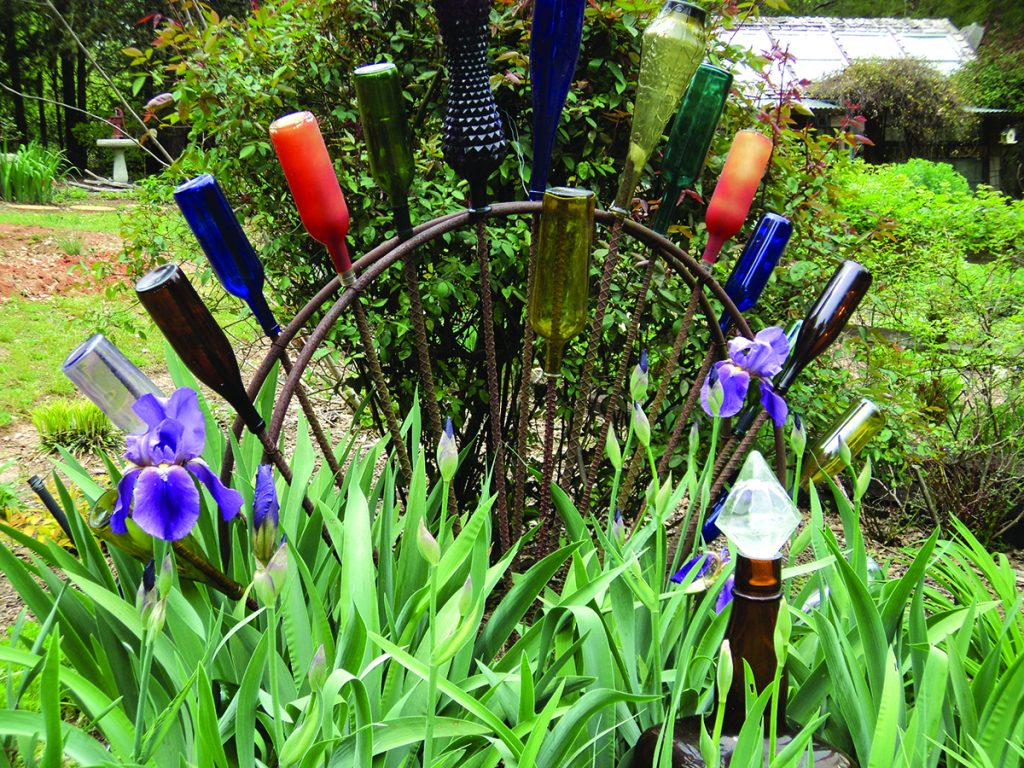A Southern Tradition…Now Garden Art
 My late grandmother on my mother’s side, known to us as ‘Mum-mum’, mum being the English version of mom, was my inspiration for gardening. Her very small home on an acre of property was surrounded by an English Cottage Garden…a garden style ahead of its time in our area. There were annuals, perennials and flowering shrubs everywhere with arbors covered with Blaze Climbing Roses and benches throughout her garden for sitting and enjoying the view. Birds, butterflies and honeybees captured my attention as they busily pollinated her garden…probably the reason for my Wildlife Habitat Garden at WillowDale. I’d like to think that one of her favorite past-times was sharing her garden and the names of various plants with her youngest granddaughter.
My late grandmother on my mother’s side, known to us as ‘Mum-mum’, mum being the English version of mom, was my inspiration for gardening. Her very small home on an acre of property was surrounded by an English Cottage Garden…a garden style ahead of its time in our area. There were annuals, perennials and flowering shrubs everywhere with arbors covered with Blaze Climbing Roses and benches throughout her garden for sitting and enjoying the view. Birds, butterflies and honeybees captured my attention as they busily pollinated her garden…probably the reason for my Wildlife Habitat Garden at WillowDale. I’d like to think that one of her favorite past-times was sharing her garden and the names of various plants with her youngest granddaughter.
Mum-mum loved all colors in her garden and to one side of her home was a colorful bottle tree welded by grandpop, a jack-of-all-trades. He was known back in the 1950’s for taking a nip or two giving her plenty of bottles for her bottle tree, spirits and all! Her amazing bottle tree entered the realm of folk art… an interesting and colorful ornament that glistened in the afternoon sun. She is the reason I have one in my garden, not quite as amazing for I’m not a welder, made from an old metal firewood ring and re-bar purchased for $5.00 at a garage sale.
Now as the bottle tree goes, there is a long history that dates back to 1600 BC in Africa, Egypt and Mesopotamia, an historical region in Western Asia. The belief was that by hanging the bottles in a tree, evil spirits would find their way into the bottles and become stuck. Since they would not be able to find their way back out again, they would remain in the bottle until morning. The morning sun would then destroy the spirits. This tradition carried over to the people of the Congo starting in the 9th century.
Later the slave trade in the 17th century brought the bottle tree tradition to Europe and America. During this time, African slaves on Southern plantations began placing bottles on trees. They commonly used Crepe Myrtle trees placing the bottles upside down with the neck facing the trunk keeping the malevolent spirits trapped until morning sun. The tradition of using the Crepe Myrtle may be connected to the Old Testament, where the Myrtle tree is a recurring image that represents freedom and escape from slavery. Thus, this creation of bottle trees during that time of history rooted the tradition in Southern United States culture.
The most popular color was blue especially Cobalt Blue. The belief was that these particular bottles have healing powers. And today, throughout the South blue remains the most dominant color for bottle tree yard art adding an attractive bit of flair and color to our gardens. Somewhat similar to the gazing ball which is another story. But for me, color bottles became my fancy, a wonderful reminder of my grandmother and her beautiful bottle tree.♦

